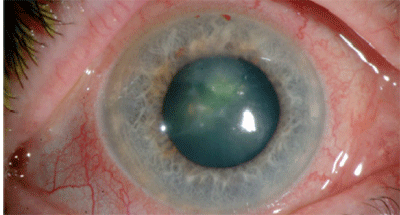Regardless of the 2006 Fusarium outbreak, infection rates of fungal keratitis may be steadily on the rise, as shown by a retrospective review of fungal keratitis infections by researchers at the University of Floridas Department of Ophthalmology.
The researchers reviewed the records of 84 Gainesville, Fla., patients diagnosed with some strain of fungal keratitis between 1999 and 2006. Until 2004, they found, trauma ranked as the highest risk factor for infection, causing 51% of the recorded cases. Contact lens use ranked second, causing only 40%.
After 2005, however, contact lens use became the primary culprit, causing 52% of the cases, while trauma only caused 29% of the recorded infections. Nontherapeutic contact lenses caused only 21% of fungal ulcers in 1999, but caused 45% of the cases in 2005 and 2006.

A 2006 case of fungal keratitis due to infection from Fusarium solani.
The study also showed that 86% of cultured organisms in these cases were filamentous. Fusarium, at 41%, was the most common strain of bacteria found, followed by Candida at 14%, Curvularia at 12% and Aspergillus at 12%.
The study suggests that infection rates are rising because of the increase in size of the contact lens-wearing population and the trend toward using multipurpose solutions, which, the study posits, are less effective than peroxide systems.
Researchers remind clinicians that topical steroids exacerbate fungal keratitis and should not be used before attaining a definitive diagnosis; eight cases reviewed had been wrongly prescribed steroid treatment. Also, the study notes the surge of fungal keratitis cases in 2006, but only as a progression from the previous years rates of infection coupled with a solitary inciting factor.
Of the patients who presented with infection, 56% had visual acuity (VA) worse than 20/200 at presentation. The majority (70%) of the patients treated medicinally achieved VA of 20/40. Of these patients, 74% received dual topical antifungal therapy, which researchers say was the most successful in treating keratitis infections. Still, 23% of patients required therapeutic keratoplasty, enucleation or corneal gluing; only 16% of surgical patients achieved VA of 20/40.
Researchers recommend using the Grocott-Gomori methenamine silver stain test in cases of suspected fungal keratitis because of its high sensitivities and rapid detection of fungal culture; in this study, the test had an 85% detection success rate. They also advise using aggressive dual topical antifungal therapy for better rates of success when treating keratitis, citing the VA achieved through this therapy.
Iyer SA, Tuli SS, Wagoner RC. Fungal keratitis: emerging trends and treatment outcomes. Eye Contact Lens 2006 Dec;32(6):267-71.

